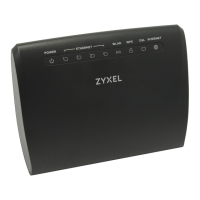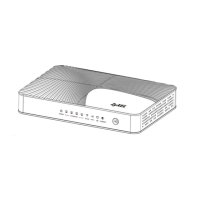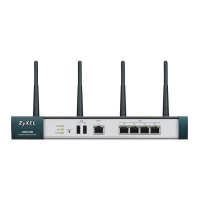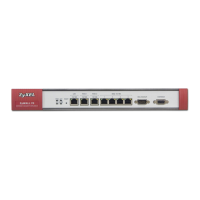Chapter 15 Quality of Service (QoS)
AMG1302-T10A User’s Guide
172
WRR Weight If you selected WRR, specify the WRR weight for each queue index. A higher weight
indicates the traffic will receive more bandwidth while a lower weight indicates it will
receive less bandwidth. For example, 15 is receives more bandwidth than 1.
Discipline Save Click this to save the discipline.
Rule&Action
Summary
Click this to open a summary table showing the QoS settings. See Section 15.2.1 on page
173 for more details.
Rule
Rule Index Select the rule’s index number from the drop-down list box.
Active Use this field to enable or disable the rule.
Application Select an application from the drop-down list box. The Destination Port Range and
Protocol ID fields may change depending on the type of applications you choose.
Physical Ports Select the port to apply the rule to.
Destination MAC Type a destination MAC address here. QoS is then applied to traffic containing this
destination MAC address. Leave it blank to apply the rule to all MAC addresses.
IP Enter a destination IP address in dotted decimal notation. QoS is then applied to traffic
containing this destination IP address. A blank destination IP address means any
destination IP address.
Mask Enter a destination subnet mask here.
Port Range Either use the default value set by the application you choose, or enter the port number
to which the rule should be applied.
Source MAC Type a source MAC address here. QoS is then applied to traffic containing this source MAC
address. Leave it blank to apply the rule to all MAC addresses.
IP Enter a source IP address in dotted decimal notation. QoS is then applied to traffic
containing this source IP address. A blank source IP address means any source IP
address.
Mask Enter a source subnet mask here.
Port Range Enter the port number to which the rule should be applied. 0 means any source port
number. See Appendix F on page 291 for some common services and port numbers.
Protocol ID Select an IP protocol type from the drop-down list box.
Vlan ID Range Enter the source VLAN ID in this field.
IPP/DS Field Select IPP/TOS to specify an IP precedence range and type of services.
Select DSCP to specify a DiffServ Code Point (DSCP) range.
IP Precedence
Range
Enter a range from 0 to 7 for IP precedence. Zero is the lowest priority and seven is the
highest.
Type of Service Select a type of service from the drop-down list box.
Available options are: Normal service, Minimize delay, Maximize throughput,
Maximize reliability and Minimize monetary cost.
DSCP Range Specify a DSCP number between 0 and 63 in this field.
802.1p Select a priority level (0 to 7) from the drop-down list box.
Action
IPP/DS Field Select IPP/TOS to specify an IP precedence range and type of services.
Select DSCP to specify a DiffServ Code Point (DSCP) range.
IP Precedence
Remarking
Enter a range from 0 to 7 to re-assign IP precedence to matched traffic. Zero is the
lowest priority and seven is the highest.
Table 64 Advanced Setup > QoS
LABEL DESCRIPTION

